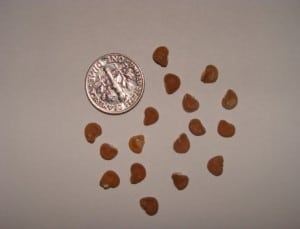| Author | Affiliation |
|---|---|
| Samuel J. Stellpflug, MD | Hennepin Regional Poison Center, Minneapolis, MN |
| Jon B. Cole, MD | Hennepin Regional Poison Center, Minneapolis, MN |
| Carson R. Harris, MD | Regions Hospital Clinical Toxicology Service and Department of Emergency Medicine, St. Paul, MN |
A 60-year-old man had just enjoyed a summer meal that included hamburgers, fruit, and lettuce salad. He finished it off with some ice cream, and to make it healthier he threw on it a handful of seeds from the cupboard that he understood to be flax seeds. What he had eaten instead was a handful of Datura inoxia, or Moonflower seeds (Figure 1). Within 30 minutes he felt “drugged,” and shortly thereafter his wife and neighbor found him upstairs in front of his closet naked and holding a belt. He was “flushed in the face” and incoherent. They summoned medics who brought the man to the emergency department (ED). In the ED his Glasgow coma score was 7, he was tachycardic and febrile, his skin was flushed and dry, and he had no discernible bowel sounds. He was intubated for airway protection and admitted to the intensive care unit. After 18 hours of supportive care he was extubated and discharged uneventfully later that day.

D. inoxia is not to be confused with Ipomoea muricata (purple moonflower) and Ipomoea alba (white moonflower).1 An ornamental plant with large white flowers, is a member of the Datura genus that also includes Datura stramonium (Jimson Weed).2 The plants in this genus contain toxic compounds in the form of the alkaloids atropine, scopolamine, and hyoscyamine.1 The entire D. inoxia plant is toxic, containing primarily scopolamine; in fact, it contains the largest amount of scopolamine of any plant.1 The seeds actually contain less scopolamine per gram than the rest of the plant. Ingestion of this substance causes antimuscarinic effects at low doses and both antimuscarinic and antinicotinic effects at high doses. These effects result in the anticholinergic toxidrome, as seen in this case.
Footnotes
Supervising Section Editor: Sean Henderson, MD
Submission history: Submitted December 9, 2009; Accepted January 11, 2010
Full text available through open access at http://escholarship.org/uc/uciem_westjem
Address for Correspondence: Samuel J. Stellpflug, MD, Emergency Medicine Department, Regions Hospital, 640 Jackson St., St. Paul, MN 55101
Email samuel.j.stellpflug@healthpartners.com
Conflicts of Interest: By the WestJEM article submission agreement, all authors are required to disclose all affiliations, funding sources, and financial or management relationships that could be perceived as potential sources of bias. The authors disclosed none.
REFERENCES
1. Defrates LJ, Hoehns JD, Sakornbut EL, et al. Antimuscarinic Intoxication Resulting from the Ingestion of Moonflower Seeds. Ann of Pharmacotherapy. 2005;39:173–6.
2. Nelson LS, Shih RD, Balick MJ. Handbook of Poisonous and Injurious Plants. New York, NY: New York Botanical Garden; 2007.
3. Kintz P, Villain M, Barguil Y, et al. Testing for Atropine and Scopolamine in Hair by LC-MS-MS after Datura inoxia abuse. J Anal Toxicol. 2006;30:454–7. [PubMed]


